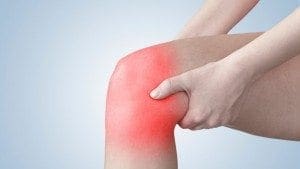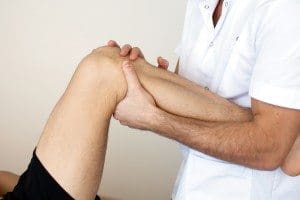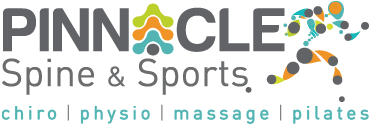 By Dr Grant Colombo, chiropractor
By Dr Grant Colombo, chiropractor
Knee pain is a very common condition presenting to health care practitioners daily. Statistics reveal that overall knee pain affects approximately 19% of the population at any given time. The percentage of newly diagnosed knee conditions increases steadily with age and is a major cause of debilitating pain in the population. Women are slightly more susceptible to knee injury however they affect both genders quite frequently. The knee is the 2nd most common injury site after the ankle and most injuries occur during sporting or competitive activities. However, research suggests that only approximately 21% of knee injuries require surgery and the remainder can be successfully managed conservatively. Chiropractic care is one option that can be extremely helpful in the treatment of knee pain and injury.
The knee is the largest joint in the human body. It is a is a complex joint and the articulating bones are held together by numerous ligaments and muscles especially the quadriceps. There is a specialised ring like cartilage called meniscus which moulds to the knees bony surfaces to separate the articulating bones and supply shock absorption whilst providing smooth favourable movement. It is a highly mobile weight bearing joint that is frequently loaded and being used on a day to day basis. Due to the weight bearing and mobile properties, the structures around and within the knee are commonly injured with non-trivial forceful movements (acute injury). Ligament, tendinous, cartilaginous, muscular and nerve injures can occur. Without prompt and adequate treatment these issues can progress to present with chronic issues.
The most common complaints, however relate to ‘wear and tear’ or osteoarthritis. Although a condition such as osteoarthritis is not curable, the symptoms can be reduced. These issues are especially common in situations where the knee is exposed to prolonged forces without adequate support and shock-absorption. Joint stiffness, catching/locking and range of motion losses are commonly reported. Irritation and inflammation of the surrounding muscles and tendons are very commonly reported in both acute and degenerative knee conditions. A large percentage of knee pain is due to damage to these supporting structures.
If you suffer from knee pain, you do not have to live with the pain, reduce your activity level, or start taking more pain medication. Have you considered the route of chiropractic treatment?
As chiropractors, we perform comprehensive history, followed by extensive orthopaedic and neurological examinations. It is only once an accurate diagnosis has been reached an appropriate management plan can be applied. The quicker the diagnosis and implementation of an adequate treatment plan, the less likely the issue will progress and continue to be debilitating in nature.
Once assessment of the knee and surrounding related structures has been completed and a diagnosis provided, a treatment plan should be implemented. Any treatment plan is most successful when modified and tailored to best suit the individual.
The stages of chiropractic care are implemented sequentially and progress is implemented according to responsiveness. The initial phase is aimed at reducing inflammation and consequent pain. The second phases are focused around stabilising and normalising joint function. The final stage is aimed at rehabilitating the involved structures for strengthening and prevention.
 Stage 1 – Reducing pain and inflammation
Stage 1 – Reducing pain and inflammation
When pain presents in the knee it is a result of damage of certain tissues and consequent inflammatory changes that occur. Using ice at the site of injury to reduce swelling and inflammation for the first few days is generally advised. Soft tissue techniques such as massage or releases can be used to improve range of motion and relieve surrounding spasm or muscle guarding. Advice to avoid aggravating activities may be given and implementation of supporting taping/bracing is also commonly suggested. Light chiropractic manipulation or mobilization techniques may be used at the knee and certain surrounding joints. These combinations of techniques assist in reducing knee pain whilst improving range of motion and joint function.

Stage 2 – Stabilising and normalising joint function
Knee injury is basically always accompanied by a loss in function. Reductions in joint proprioception as well as surrounding muscle weakness due to pain inhibition occurs. Certain compensations occur in the body to minimise the effects on human functioning. It is common to get certain movement restrictions and consequent compensations in surrounding joint mobility. To account for the lack in movement in affected areas, surrounding areas must accommodate for this may become hypermobile and symptomatic. It is therefore important that these joints and structures are cared for and their normal function is restored. Deep soft tissue work including muscle release techniques, trigger point therapy and cross friction myofascial may be applied to reduce tone and lengthen tight areas of muscle spasm and hypertonicity. Specific chiropractic adjustment and mobilisation techniques to specific areas of the knee and surrounding joints are generally required to help increase and restore movement and functionality whilst addressing pain and discomfort.
 Stage 3 – Rehabilitation and maintenance
Stage 3 – Rehabilitation and maintenance
Once functionality has improved to the knee and surrounding joints it is imperative to ensure these improvements are maintained. Activity specific and strengthening exercises will likely be prescribed. These activities help strengthen affected areas and improve proprioception and co-ordination that has been lost due to injury and the presence of pain. For optimal joint performance, the supportive structures that may have been damaged need to be adequately functioning. This will not only facilitate healing but also ensure re-injury is less likely. Adherence to the strengthening/co-ordination exercises is important so these tissues are appropriately conditioned for the prevention of injury and pain free functioning.
Often with rehabilitation exercises, certain weakened muscles will be strengthened and this is likely to affect joint centration and range of motion. Adjustments and mobilizations to the knee and associated joints will be continued. This will ensure all required range of motion and functionality is maintained. If the surrounding joints and tissues are not working correctly, they can place increased stress on the recently healed knee joint leaving it prone to re-injury. It is important not to leave knee pain alone. It is always suggested to get health care advice from a professional and chiropractic treatment with ongoing management is perfect to maximise long term improvement in function whilst addressing injury prevention.
Do you have knee pain that you would like to get checked out? Call us on 9743 2311, or email grant@wordpress-618427-3319396.cloudwaysapps.com to find out more about how we can help you.
[su_youtube url=”https://youtu.be/hxlyK0Tz4ew” width=”300″ height=”200″]
